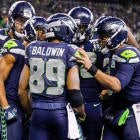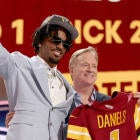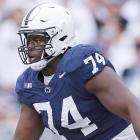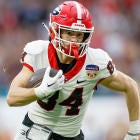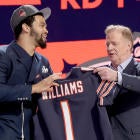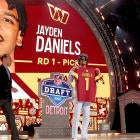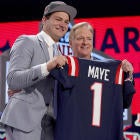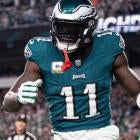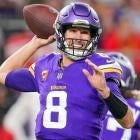By almost every measure, the Seahawks are a good football team and have been a good football team for a while now.
Since the dawn of the Russell Wilson era, they've averaged 10.7 wins per season and have only missed the playoffs once. Wilson has developed into one of the best quarterbacks in the league. Since the departure of Tom Cable, the offensive line is no longer a fatal flaw. Despite undergoing a purge of mainstays from the franchise's iconic championship roster, the Seahawks' defense has managed to remain relatively strong while also getting younger. The Seahawks might be more of a potential usurper than the actual king in the NFC West, but make no mistake about it, they underwent a transition that would've crippled most teams and almost immediately reemerged from that process as a playoff-caliber team. It's impressive.
Except that, concerns still do exist. On defense, the Seahawks let star safety Earl Thomas walk to the Ravens in free agency and traded their best edge defender, Frank Clark, to the Chiefs. On offense, the Seahawks will be lacking their best skill-position player, receiver Doug Baldwin, who unexpectedly was forced to retire at the age of 30 due to injuries.
It's the loss of Baldwin that might be the most concerning. After all, the Seahawks did well to replace Clark with a great buy-low signing in Ezekiel Ansah and first-round pick L.J. Collier. They proceeded to draft safety Marquise Blair in the second round. Once upon a time, we watched Pete Carroll and John Schneider build the Legion of Boom. Over the past couple of years, we've watched them part ways with nearly every member of that heralded defense to build a younger unit. So far, the process appears to be going well. The Seahawks ranked 14th in defensive DVOA and 11th in points allowed this past season. It's easier to trust the Seahawks braintrust's ability to replace Thomas and Clark than its ability to replace Baldwin.
In Baldwin's eight-year career, during which he went from an undrafted free agent to the league's best slot target, he averaged 61.6 catches, 820.4 yards, and 6.1 touchdowns per season. In 13 playoff games, he caught 58 passes for 734 yards and six touchdowns. It won't be easy, but the Seahawks will have to find a way to replace that kind of production if they want to overtake the Rams in the NFC West.
With that in mind, let's take a look at three ways the Seahawks can overcome Baldwin's sudden departure.
1. Increase Tyler Lockett's slot usage
The thing about Doug Baldwin is that while he might've been only one of the league's best receivers, he was the league's best slot receiver. According to Pro Football Focus, no receiver garnered a higher slot receiving grade than Baldwin from 2011-18 and 65.3 percent of Baldwin's routes last season came from the interior.
So in that sense, it's not just about the Seahawks finding a way to replace Baldwin's typical yearly output. It's more about finding a way to replace his effectiveness out of the slot. Luckily, the best receiver still on the team's roster appears to be ready for a heavier slot role.
The team's new best receiver is Tyler Lockett, who is coming off a breakout season that included 57 catches, 965 yards, and 10 touchdowns. He averaged an awesome 13.8 yards per target and 16.9 yards per catch in 2018.
But it might make sense for the Seahawks to increase his slot usage now that they're down Baldwin. According to PFF, Lockett led the league with an 89.7 reception percentage out of the slot -- ranking one spot ahead of DeAndre Hopkins and two spots ahead of Michael Thomas. That shouldn't come as a surprise. According to NFL Next Gen Stats, Lockett ranked third among all receivers last season with a 81.43 catch rate. Only Michael Thomas and Ryan Switzer (seriously) ranked ahead of him.
Baldwin missed three games last year: Weeks 2, 3, and 14. In those games, the Seahawks faced three strong defenses in the Bears, Cowboys, and Vikings.
Without Baldwin in Week 2, Lockett caught five passes for 60 yards and a touchdown.

In Week 3, Lockett caught four passes for 77 yards and a score.

Finally, in Week 14, Lockett caught five passes for only 42 yards, but look at his route chart (via NFL Next Gen Stats), because it's remarkably diverse and could be a preview of what's to come in 2019 -- ideally with a few more yards along the way.

Offensive coordinator Brian Schottenheimer has said he plans to move Lockett around the field, which makes sense. The Seahawks don't want to turn Lockett into only a slot receiver when he's also productive on the outside. But it also sounds like we should expect Lockett to get more looks from the slot, which also just happens to be the way his usage was already trending.
Tyler Lockett's snap breakdown over the years:
— PFF SEA Seahawks (@PFF_Seahawks) June 4, 2019
2015 - 211 in the slot, 543 out wide
2016 - 166 in the slot, 382 out wide
2017 - 348 in the slot, 336 out wide
2018 - 457 in the slot, 496 out wide https://t.co/LE55FB6G2c
According to The Seattle Times' Bob Condotta, when the Seahawks operated out of three-receiver sets at OTAs, Lockett often lined up in the slot.
2. Get the most out of D.K. Metcalf
With Lockett in the slot, there are two openings on the outside.
Condotta also reported for The Seattle Times that the three starting receivers at OTAs were Lockett, Jaron Brown, and David Moore -- with Lockett on the inside, and Brown and Moore on the outside. Last year, Brown and Moore combined to catch 40 passes for 611 yards and 10 touchdowns. Perhaps they'll improve, but those are not starting receiver kind of numbers.
The key is D.K. Metcalf and how quickly he develops at the next level. Regarded by many as a top-15 pick after his impressive combine performance, Metcalf fell to the Seahawks at the end of the second round. Regardless of how you feel about his overall game, there's no denying his potential to erupt as a downfield target. NFL.com's Lance Zierlein compared him to Josh Gordon.
Nobody should expect him to contribute in Week 1 as an all-around receiving threat -- making the transition from college to the pros is difficult enough for more refined receivers. But if the Seahawks can harness his unique skillset, they should be able to turn him into an impact-now player who can provide them with explosive plays down the sidelines -- the kind of plays they could be short on if Lockett shifts primarily to the slot.
And here's where it's worth noting that Wilson might have the best deep ball in football in terms of accuracy. Wilson ranked fifth last season in average intended air yards, according to NFL Next Gen Stats -- one spot ahead of Patrick Mahomes. He still managed to complete 65.6 percent of his passes. According to NFL Next Gen Stats, Wilson's expected completion percentage was 60.4. So, Wilson outperformed his expected completion percentage by 5.2 percent -- the fourth-highest completion percentage above expectation.
If Metcalf's explosiveness is harnessed by the Seahawks, he could form a dangerous combination with Wilson to provide the Seahawks with the chunk plays they need.
3. Throw the ball more on early downs
Replacing Baldwin won't just be about the players. They'll need help from the coaching staff. This is probably the Seahawks' biggest overall concern heading into the upcoming season.
Under Schottenheimer, the Seahawks adopted a run-first approach last season. Only the Ravens racked up more rushing attempts than the Seahawks. To a degree, it worked. The Seahawks finished the season first in rushing yards. The problem is, the Seahawks relied too heavily on running the ball.
It's an argument that was there all along -- no team attempted fewer passes than the Seahawks over the course of the season -- but gained serious steam when the Seahawks saw their season end against the Cowboys in the playoffs. In that game, the Seahawks' three running backs combined for 59 yards on 21 carries. Wilson didn't get enough chances to influence the outcome of the game.
Warren Sharp's postgame Twitter thread captured the problem brilliantly:
Seahawks fans, we're going to have a long talk about Brian Schottenheimer.
— Warren Sharp (@SharpFootball) January 6, 2019
Seattle doesn't have Blake Bortles or Case Keenum at QB.
This is Russell Wilson.
16 Wilson passes @ 8.3 YPA vs
21 non-Wilson runs @ 2.8 YPC
One of the worst called games w a good QB I can remember.
Russell Wilson averaged 8.6 YPA & recorded a 106 rating.
— Warren Sharp (@SharpFootball) January 6, 2019
The Seahawks RBs averaged 2.8 YPC on 21 runs.
In the 1st half on 1st downs, your:
• runs averaged 2.0 YPC
• passes averaged 14.5 YPA
and yet you kept running on 1st down in the 2nd half like it was +EV vs passing.
In the first half Wilson was 7/11 with 8.8 YPA.
— Warren Sharp (@SharpFootball) January 6, 2019
Your RB-run game gained 19 yards on 9 carries, 2.1 YPC. Your longest run was 5 yards.
And yet you came out the locker room on the 1st drive and went:
1st & 10: 1 yard RB-run
2nd & 9: 3 yard RB-run
3rd & 6: predictable pass
PUNT
Trailing on every offensive play of the 2nd half & knowing the run game was burnt, you went full DGAF:
— Warren Sharp (@SharpFootball) January 6, 2019
1st down play calls on your first 4 drives of the 2nd half:
6 RB-runs: 3.9 YPC, 14% success rate
1 pass: 9 yards, 100% success rate
HOW. DO. YOU. DO. THIS. TO. YOUR. TEAM?
The best way to ease the burden on Wilson -- suddenly without his best receiver who has always been there for him throughout his career -- is to put him in more pass-friendly situations. The Seahawks need to stop running the ball on first and second down before asking Wilson to bail them out on third down, when defenses know they're facing a passing play.
As Josh Hermsmeyer chronicled over at FiveThirtyEight, the Seahawks used rush-rush-pass sequences 26 percent of the time last season. The league average was 16 percent. Only 41.2 percent of those sequences ended successfully. But when the Seahawks went pass-rush-rush, they were successful 88.9 percent of the time. When they went pass-pass-rush, they were successful 71.4 percent of the time. When they went pass-rush-pass, they were successful 50 percent of the time.
As Hermsmeyer explained, this isn't a Seahawks-specific problem. Rush-pass-pass is one of the least successful sequences for every team. That's why it's especially problematic that the Seahawks use that sequence way more than any other team. Even Seahawks left tackle Duane Brown said after the season that they ran the ball too much.
Throwing the ball on third-and-long isn't easy. It's not easy for the quarterback to go up against pass rushers who aren't worried about a running back flying past them through their gap. It's not easy for the receivers going up against defensive backs who aren't concerned about stepping up to stop the run. It won't be any easier for the Seahawks, who are suddenly without their best receiver and route runner.
The Seahawks can overcome that loss with better coaching. Unfortunately, better coaching doesn't seem likely, because Schottenheimer is doubling down on his approach, recently saying "We make no apologies for how we play."
Chances are, you'll be see a whole lot of tweets like this one during the upcoming season.
me if the seahawks go run-run-pass all game pic.twitter.com/aBGYOKueCK
— Mina Kimes (@minakimes) October 7, 2018













